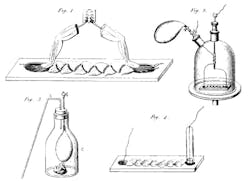Frog Legs Probably Won’t Charge Your Phone—the Discovery of Voltage
Download this article in PDF format.
I don’t have any frog legs on my testbench. But that’s because I don’t live in the late 1700s (which is probably a bit obvious since you are reading this online). Back in the day, though, in place of my oscilloscope would be a frog galvanoscope. I personally prefer my oscilloscope. It’s less stinky and much more accurate.
So, how did we start using frog legs for measurement in the first place? The answer takes us through 150 years of history, culminating in one of the lesser-known engineering rivalries in history: Galvani vs. Volta (Fig. 1).
Charging Up to a Stable Voltage: Electrostatics and Capacitors
It seems tautological to say that Alessandro Volta discovered the volt, and it is. (How’s that for tautological?) But, there’s a lot more to the story! Experiments with static electricity began at least as far back as the ancient Greeks. They discovered that rubbing amber with cloth caused sand and dust to stick to it (we now know this colloquially as “static cling”).
Fast forward to the mid-1600s. Otto van Guericke hoped to create an experiment with “cosmic potencies” when he invented an electrostatic generator. Guericke is known for pioneering vacuum research, but his electrostatic generator (later improved by the likes of Isaac Newton), kick-started experiments with electricity. Thanks to the electrostatic generator, scientists could now consistently create static charge.
This led to the invention of the first man-made capacitor, the “Leyden jar,” circa 1745. We’ve all heard that Benjamin Franklin experimented with electricity (and infamously mis-identified the direction of current flow) by flying kites in thunderstorms—he used Leyden jars. So by the 1750s, scientists could now both create and store electric charge by connecting an electrostatic generator to a Leyden jar.
Charging Up
Electrostatic generators and Leyden jars were useful for experiments, but no one had yet figured out how to create a constant voltage source. Cue researcher Luigi Galvani circa 1780. He (or his assistant) was skinning a frog leg to acquire skin for some electrostatic experiments. Because, let’s be honest, skinning a frog leg is probably a job for your assistant (or chef).
The aforementioned frog leg was attached to a brass hook for stability, and the steel scalpel being used touched a nerve. This caused the frog leg to kick! This particular leg had the peculiar misfortune of not being attached to its original owner, so this phenomenon was more than just a curiosity. Why did this happen; how did the frog leg kick? It was generally accepted that electricity was the culprit, but what sourced it?
Thus began nearly 20 years of scientific controversy.
Galvani vs. Volta
Two schools of thought prevailed. Galvani thought that this phenomenon was not created by normal electricity but “animal electricity,” a hypothetical unique-to-animals electrical fluid that nerves carried to muscles. On the other side of the rivalry was Volta. Volta believed that the “animal electricity” and the electricity from electrostatic generators and Leyden jars were one and the same. This rationale led Volta to believe the reason Galvani’s frog legs kicked was a result of the metals used, not the animal tissue.
Biobatteries
The next 20 years were devoted to experimenting and finding the answer. One notable discovery was made in 1790 by Eusebio Valli—the “frog battery.” As it turns out, you actually can source electricity from tissue, even though this isn’t what caused Galvani’s frog kick. Valli learned he could create a crude biobattery by chaining together the thigh muscles of frogs (sketches shown in Figure 2). This seemed to support the theory of “animal electricity” and, along with Galvani’s discovery, pioneered the field of bioelectromagnetics.
This discovery only muddied the waters. The frog battery seemed to support the idea of animal electricity, but its electrical potential is actually a result of “injury potential” in damaged tissue. Due to the way muscles store and release energy, physically damaged tissue will have a slightly negative charge. In this case, the preparation of the specimens damaged the tissues enough to create voltage across the muscles. Nesting the damaged tissue in series created a short-term voltage supply. The same chemistry is what causes fresh frog legs to twitch when salted (it’s a little terrifying, look it up).
Throughout the late 18th and early 19th, century a number of different biobatteries were created, including one made out of a chain of ox heads. One of the main electrical sensors on scientist’s testbench was a “frog leg galvanoscope.” All I can say about that is: Electrical engineering ain’t what it used to be.
Electrochemistry—as Cool as It Sounds
Biobattteries aside, what made Galvani’s frog leg kick? Unfortunately, my circuit CAD software doesn’t have presets for anything close to “steel scalpel,” “frog leg,” or “brass hook,” so words will have to suffice. And maybe some new CAD software.
The frog kick was caused by the same thing that makes lemon batteries and potato clocks tick (see Figure 3, a lemon battery measuring over 900 mV on a Keysight 1000 X-Series oscilloscope). The frog’s nerves don’t contain “animal electricity” (which is decidedly not a thing), but instead provide a connection to a muscle’s electrolytes, allowing a redox reaction. The brass hook (remember, brass is copper & zinc) oxidized (gave up electrons) and the steel reduced (gained electrons). The nerve basically acted as a conductive solution that encouraged and enabled the redox reaction. And since there was a flow of electrons, there was an electrical current. And, finally, applying current through the frog’s muscles caused them to spasm.
While this explanation makes sense to us, it would be hard to understand the frog’s kick in the 1700s—a hundred years before the discovery of the electron. Naturally, Volta and Galvani continued to follow their respective branches of research hoping for a breakthrough.
The First Battery
Then, in 1799, Volta published his historic discovery: the voltaic pile (or “voltaic stack,” as shown in Figure 4). Volta discovered that he could create a constant voltage by placing saltwater soaked cardboard between copper and zinc plates. To make things better, varying voltages could be created by stacking multiple cells together. The first battery! Ironically, though, Benjamin Franklin coined the term “battery” 50 years earlier to describe series-connected capacitors (this is an Alanis Morissette-artistic-liberty usage of “ironic,” not a “this is literally ironic” usage).
Anyway, this battery used the same reduction-oxidation process as Galvani’s frog leg, sans cuisses de grenouille. This was a significant leap for science. Now, experiments could be done with constant voltage instead of being limited to just a quick zap from a Leyden jar. The inventions and discoveries that resulted from this are too numerous to list, but a couple notable ones include the isolation of a number of new elements and electrolysis of water.
My favorite experiment, though, left a lasting mark on the literary world. Yep, you read that correctly. Galvani’s nephew, Giovanni Aldini, toured Europe promoting the idea of “animal electricity” while simultaneously using a voltaic stack for his demonstrations. In 1803, he gave a demonstration showing how electricity could cause muscles to tense and move, with a recently executed criminal as his test subject. Without going into graphic detail (use your imagination), the demonstration clearly left a mark on the audience. In the audience? A young Mary Shelley, who later went on to write the legendary “Frankenstein.”
Charging Down
Harnessing electricity is undeniably one of the most significant advances in human history, and how we use electricity continues to improve our lives and evolve on a yearly basis. Historically, it’s unique in the sense that we know how it came to be. Fire, language, the wheel, and mathematics all have their roots so far in the past that we can’t track it. Electrical engineering’s origins, however, we can track precisely.
So, next time you’re stuck in the weeds of a tough design challenge (or even changing a hard-to-reach lightbulb), take a moment to appreciate that a mere 400 years ago, the farthest humanity had progressed in this field was some guy rubbing a sulfur ball with a piece of wool for sparks and giggles.
Author’s note: no frogs were harmed in the writing of this article.
About the Author

Daniel Bogdanoff
Oscilloscope Product Manager
Daniel Bogdanoff is the Product Manager for the InfiniiVision series of oscilloscopes at Keysight Technologies. He graduated from Texas A&M with a degree in electrical engineering. In his spare time, Daniel enjoys whitewater kayaking, mountain biking and playing various musical instruments.





